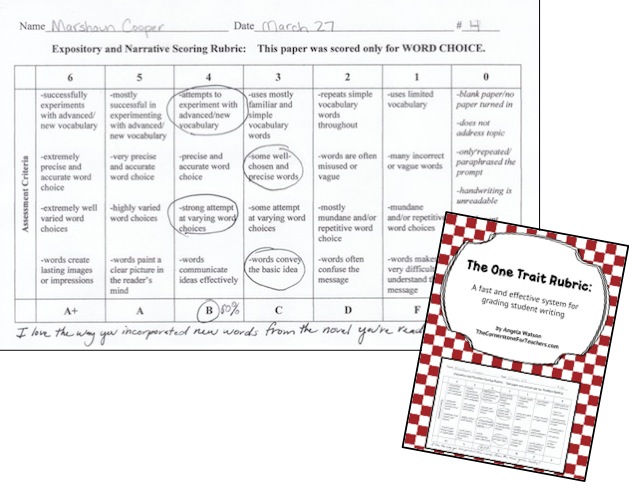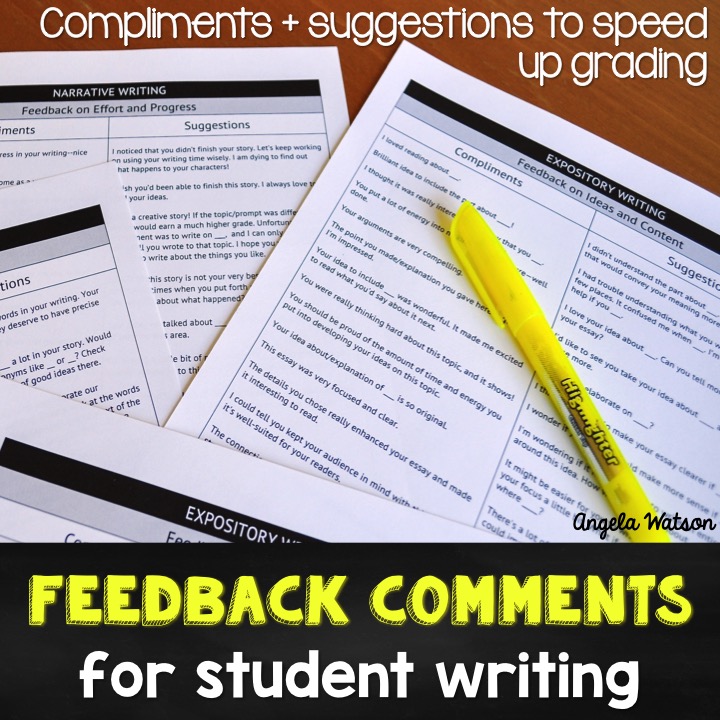
Grading students’ essays and stories can be extremely time-consuming. Here are some ideas for grading student writing more quickly and easily (and making the experience more meaningful for students):
1. Don’t correct every mistake you see.
Sure, we want to make students aware of their errors. But pointing them all out at once can be overwhelming and discouraging to kids. Not to mention the fact that it takes FOREVER for the teacher to do! It’s much more manageable for the teacher and the students when you focus on one or two writing skills per assignment.
2. Use a rubric to grade student writing on only one criteria at a time.
If your district will allow it, grade each essay only on the writing skill you’re currently teaching (conventions, focus, organization, etc.) I photocopied one rubric for each of the six traits and wrote at the top “This paper was scored ONLY for ___.” and filled in the name of the trait. As students turned in their essays, they stapled the corresponding rubric to their paper.
When I read the essays, I stayed focused on the criteria listed on the rubric and circled the appropriate levels. All that was left to do at that point was leave feedback comments. Parents and students were clear on the criteria for assessment, and I was able to score the papers much more quickly because I wasn’t bogged down by analyzing all the writing skills/traits at once.
3. Make editing a collaborative process instead of a teacher-directed one.
Editing students’ papers usually isn’t the best use of your time: kids don’t learn very much when they’re handed a paper that has all the editing already done for them. Instead, teach students how to work together to edit and help one another fine-tuning their writing. Peer editing checklists are a great tool! You can also facilitate the editing process in writing conferences or mini-lessons: students will get a lot more out of the editing process when it’s completed with your guidance, they’ll be less likely to make the same mistakes again.
4. Consider writing on sticky notes instead of directly on students’ papers.
While some kids don’t care, it can be heartbreaking for a child to pour her heart and soul into a story and see it returned with red marks all over the place. Placing your comments on a separate sheet of paper or a sticky note lets you provide feedback while still showing respect for students’ ownership of their work and leaving their writing intact.
This also reassures parents that you are paying careful attention to students’ writing and giving constructive feedback, even though you aren’t pointing out every spelling error and misplaced comma on the paper. If you use the rubric tip I mentioned earlier, you can make it your policy to only write on the rubric.
5. Give feedback orally in writing conferences.
Make a schedule and meet with 2-5 students each day while the rest of the class is writing independently or collaboratively. It’s much quicker (and more meaningful) to talk about student writing than it is to write out every single piece of your critique.
6. Have students use Google Drive for writing.
That’s really an entire post unto itself, but in summary: Google Docs is a free cloud-based tool that will let you access all your students’ writing under your Google login. You can highlight text, leave comments, and participate in the editing process quickly and easily. Each collaborator in the Google Doc can use a different color for his or her work so it’s easy to distinguish between what a student wrote, what a peer co-editor added, and what the teacher added.
Here are some helpful resources: Grading papers with Google Docs made easy; How Google Docs supports collaboration in the writing process; and Using Google Docs to improve student writing.
7. Create a document of frequently-used comments for students’ writing and copy/paste from it.
I like to include three sentences when grading student writing: an initial compliment on something the child has done well, then a suggestion for improvement, followed by another compliment. It can be difficult and time-consuming, though, to come up with original, carefully worded, and encouraging comments for students, so I recommend writing them out one time and then copying and pasting from there.
If you don’t feel like creating your own, you can purchase my 21-page PDF Feedback Comments for Student Writing. It contains hundreds of comment suggestions you can use for written feedback. The comments can also be used to guide your conversations during writing workshop and writing conferences, and to describe student writing for portfolio assessments, progress reports, report cards, or in parent conferences.
8. Type your feedback comments instead of hand-writing them.
You can copy and paste from the document I created (above) or from your own typed comments. Put your comments for the entire class in one document, separated by student names. Print the pages out, cut them into strips, and staple each one onto student work.
The next time you need to grade student writing, half of your work will already be done for you, and you can share much more detailed feedback than if you had to handwrite the same basic things over and over. It’s also easier to see what feedback you gave each student in the previous assignment: you can see if the student made progress in the areas you suggested and make sure your next set of feedback is different.
9. Focus on the quality of work over quantity of work.
Rather than have students crank out essay after essay, try to go as slow as your curriculum and district will allow. Students will produce better writing when they have extra time to think, create, and edit, and you’ll be able to give more detailed feedback because you’ll have fewer essays to grade.
10. Have students self-assess.
This is a useful strategy even when you later grade the work yourself, but if you’re not required to take a formal grade for every piece of writing your students produce, consider letting the kids’ self-assessments suffice. They can score their work using a rubric, and/or write about what they did well and what they think could be improved.
You can then talk about students’ self-assessments in writing conferences, or just add a comment or two to what the student wrote and send the work home. This is a great way to acknowledge that becoming a skilled writer is a process, and allow students to reflect on and celebrate their own personal journey.
How do you save time when grading student writing? Do you have any tips for manageable ways teachers can give students meaningful feedback? Share your ideas in the comments!

Angela Watson
Founder and Writer
Sign up to get new Truth for Teachers articles in your inbox
Discussion
OR

Join our
community
of educators
If you are a teacher who is interested in contributing to the Truth for Teachers website, please click here for more information.


















@Mandi, Mrs. Scofield, and Sahily,
Just in case you subscribed to comments for this post, I thought I’d let you know that I just finished creating the rubrics and they are available on TPT here: http://www.teacherspayteachers.com/Product/The-One-Trait-Rubric-A-fast-effective-system-for-grading-student-writing-1185050. 🙂
Fantastic items from you, man. I have consider your stuff previous
to and you’re just extremely great. I really like what you have received here, certainly like what you’re saying and the way in which you
assert it. You’re making it entertaining and you still take
care of to keep it smart. I cant wait to read much more from
you. That is really a great web site.
Thanks for the tips! Google Docs has literally changed the way I teach. I LOVE IT! Students write, collaborate, share, edit and revise. Students are much more engaged because their classmates are reading their work and commenting on it. Their voices and word choice have improved dramatically. Plus, I can pop into their papers at anytime to help. I had students working on their summer adventure story (first one back to school) over Christmas break. (You can set up notifications to track students.) That would never happen if their papers were in a notebook.
Yes! I have found Google Docs transformative, too.